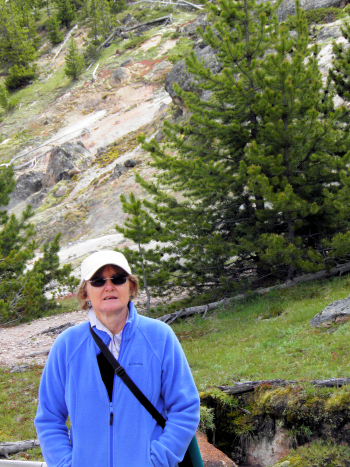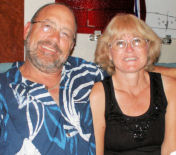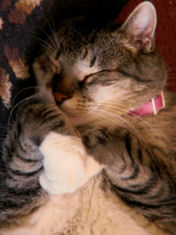The Great MisAdventures of David & JoEllen Laurita
Our Fulltime RV Adventures Across America With Toby The Cat
Great MisAdventures Summer 2011
Yellowstone National Park ~ History

Lions Head Peak ~ We are camped at the base of this mountain.
Yellowstone National Park covers 3,648 square miles in Wyoming, Montana and Idaho. It is the largest national park in the continental United States and the largest wildlife preserve. Yellowstone covers more than 2.2 million acres and is 63 miles wide from North to South and 54 miles East to West. The highest point in the park is Eagle Peak at 11,358 feet elevation. The lowest point is Reese Creek at 5,282 feet.
Native Americans used this area for thousands of years hunting and living off the land. The mountain men trapped beaver in this region in the early 1800's. The tales they told included "geothermal curiosities", "peetrified trees a-growing, with peetrified birds on 'em a singing peetrified songs", and "mountains made of glass". Our government sent many expeditions into the area and finally Yellowstone became the United States' first national park when, in 1872, President Ulysses S. Grant signed the bill that created the park.
A portion of the park containing Yellowstone Lake is centered over the Yellowstone Caldera, the largest super-volcano in North America. This caldera formed over 640,000 years ago when the volcano last erupted. Magma layers under the caldera feed the geysers and hot springs in Yellowstone National Park. There are more than 10,000 thermal features and 300 active geysers in the park. There are also about 2,000 earthquakes a year here due to the activity of the molten magma one mile below the surface.
Yellowstone National Park ~ Artist's Paint Pots
June 18, 2011

 At Paintpot Hill |
Today's MisAdventure is to the Artist's Paint Pots at Paintpot Hill. Smelling like rotten egg, the mudpots are formed by hydrogen sulfide gas working its way up from its deep origins, mixing with water along the way. This combination creates a weak form of sulfuric acid, dissolving the rock at the surface turning it into thick viscous mud. Carbon dioxide, steam, and hydrogen sulfide gasses explode through the mud in the whimsical bursting bubbles that entertain us today. Explorer Nathaniel Langford had to use his imagination to describe these somewhat indescribable features:
|
We find a hillside covered with hot springs, small geysers and mudpots and take a short hike around and up the hill to view these features from various angles. Amazing beauty surrounds us as we gaze with wonder on these springs and contemplate Mother Nature.
The reddish color in the pools is the result of the presence of iron oxide minerals. The yellow, orange, brown, and green colors result from the algae and bacteria that grow in thermal waters. The color of true beauty. Could this be the palette that God used to create the colorful canvas of Yellowstone?
Yellowstone National Park ~ Norris Geyser Basin
|
The Norris Geyser Basin, considered by many scientists to be the hottest and most changeable of Yellowstone’s thermal areas, sits at the intersection of three major faults. There is evidence that hydrothermal features have existed at Norris for at least 115,000 years. The features in the basin may change daily, with frequent disturbances from seismic activity and water fluctuations. Norris is home to Steamboat Geyser, the tallest active geyser in the world. The majority of the area’s geysers and hot springs have temperatures exceeding the boiling point and many are acidic, with pH values of 2-4.Porcelain Basin, one of the three areas of Norris, resembles an alien landscape. The area’s open terrain is covered with sheets of geyserite and bleached rock, and is punctuated by hundreds of densely packed hydrothermal features. |
 |
 |
In contrast to Porcelain Basin, Back Basin is forested and its features are more scattered and isolated. Steamboat Geyser, the tallest active geyser in the world, is found here, as is Echinus Geyser, one of the largest known acid-water geysers. The One Hundred Spring Plain is an off-trail section of Norris Geyser Basin. This area is flat, sandy, and extremely dangerous. Much of the underlying ground is hollow and many of the thermal features are acidic. Most of the hot springs in this area have never been named. We did not visit this section of the basin. |
Bison on the road, Bison on the boardwalks, everywhere Bison today.
Next Page of The Great Yellowstone MisAdventure
Our MisAdventures
- The Great Ongoing MisAdventure
- The Great Yellowstone MisAdventure
- The Great 2011 MisAdventure
- The Great 2010 MisAdventure
- The Great Tree Sales MisAdventure
- Fall 2009
- The Great Workamping MisAdventure
- Spring 2009
- The Great 2008/09 Quartzsite MisAdventure
- The Great Mexican Cruise MisAdventure
- Fall 2008
- Summer 2008
- Spring 2008
- The Great 2007/08 Quartzsite MisAdventure
- Fall 2007
- Summer 2007
- Spring 2007
- The Great 2006/07 Quartzsite MisAdventure
- October 2006
- September 2006
- The Great 2006 Northwest MisAdventure
- The Great Caribbean Cruise MisAdventure


